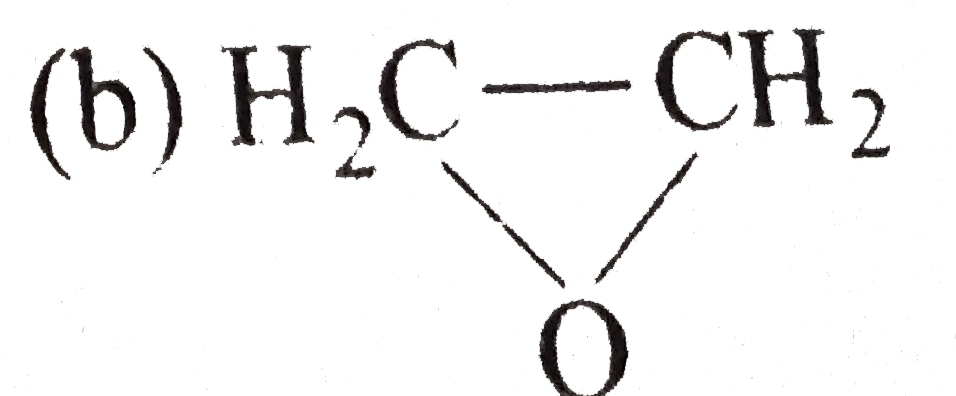When ethyl chloride is heated with AgCN, the main product is :
ethyl cyanide
ethyl isocyanide
ethyl amine
ethyl nitrate
The correct Answer is:B
To solve the question of what the main product is when ethyl chloride is heated with AgCN, we can follow these steps:
Step 1: Understand the Reactants
- Ethyl chloride (C2H5Cl) is an alkyl halide where a chlorine atom is attached to an ethyl group.
- Silver cyanide (AgCN) contains the cyanide ion (CN⁻), which can act as a nucleophile.
Hint: Identify the functional groups present in the reactants to understand how they might interact.
Step 2: Identify the Nature of AgCN
- AgCN is a covalent compound that can dissociate to provide the cyanide ion (CN⁻) and silver ion (Ag⁺).
- The cyanide ion can act as a nucleophile due to the presence of a negative charge.
Hint: Recognize that nucleophiles are species that can donate a pair of electrons to form a new bond.
Step 3: Mechanism of Reaction
- When ethyl chloride is heated with AgCN, the cyanide ion (CN⁻) attacks the carbon atom of the ethyl chloride.
- This attack leads to the displacement of the chloride ion (Cl⁻), which is a good leaving group.
Hint: Remember that nucleophilic substitution reactions often involve the replacement of a leaving group with a nucleophile.
Step 4: Determine the Product
- The nucleophilic attack results in the formation of a new bond between the carbon atom of the ethyl group and the nitrogen atom of the cyanide ion.
- The product formed is ethyl isocyanide (C2H5N≡C), where the cyanide group is attached to the ethyl group.
Hint: Consider the structure of the product to confirm that it matches the expected outcome of the reaction.
Step 5: Conclusion
- The main product of the reaction between ethyl chloride and AgCN when heated is ethyl isocyanide.
Final Answer: Ethyl isocyanide (C2H5N≡C).
Summary of Steps:
1. Identify the reactants and their functional groups.
2. Understand the role of AgCN as a source of cyanide ion.
3. Analyze the mechanism of nucleophilic substitution.
4. Determine the structure of the resultant product.
5. Conclude with the name of the product.
- Ethyl chloride (C2H5Cl) is an alkyl halide where a chlorine atom is attached to an ethyl group.
- Silver cyanide (AgCN) contains the cyanide ion (CN⁻), which can act as a nucleophile.
- AgCN is a covalent compound that can dissociate to provide the cyanide ion (CN⁻) and silver ion (Ag⁺).
- The cyanide ion can act as a nucleophile due to the presence of a negative charge.
- When ethyl chloride is heated with AgCN, the cyanide ion (CN⁻) attacks the carbon atom of the ethyl chloride.
- This attack leads to the displacement of the chloride ion (Cl⁻), which is a good leaving group.
- The nucleophilic attack results in the formation of a new bond between the carbon atom of the ethyl group and the nitrogen atom of the cyanide ion.
- The product formed is ethyl isocyanide (C2H5N≡C), where the cyanide group is attached to the ethyl group.
- The main product of the reaction between ethyl chloride and AgCN when heated is ethyl isocyanide.
1. Identify the reactants and their functional groups.
2. Understand the role of AgCN as a source of cyanide ion.
3. Analyze the mechanism of nucleophilic substitution.
4. Determine the structure of the resultant product.
5. Conclude with the name of the product.
Topper's Solved these Questions
- BOOK - OP TANDONCHAPTER - HALOALKANES AND HALOARENES EXERCISE - Objective Questions Lavel -B48videos
HALOALKANES AND HALOARENES
- BOOK - OP TANDONCHAPTER - HALOALKANES AND HALOARENES EXERCISE - Objective Questions Lavel -B Set II This set contains the questions16videos
HALOALKANES AND HALOARENES
- BOOK - OP TANDONCHAPTER - HALOALKANES AND HALOARENES EXERCISE - Problems based on structure and properties18videos
HALOALKANES AND HALOARENES
- BOOK - OP TANDONCHAPTER - ELECTROCHEMISTRYEXERCISE - Matrix-Matching Type Question3videos
ELECTROCHEMISTRY
- BOOK - OP TANDONCHAPTER - ISOMERISM (STRUCTURAL AND STEROISOMERISM)EXERCISE - INTEGER7videos
ISOMERISM (STRUCTURAL AND STEROISOMERISM)
Similar Questions
What happens when :
(i) An alkyl halide reacts with AgNO2 and product is reduced.
(ii) An alkyl halide is treated with AgCN and product is hydrolysed.
(iii) Methyl magnesium bromide is treated with cyanogens chloride.View SolutionWhen acyl chloride is heated with Na Salt of a carboxylic acid the product is
View Solution
Knowledge Check
- Question 1 - Select One
When ethyl bromide is treated with moist Ag2O main product is//are.
AEthyl etherBEthanolCEthoxy ethaneDAll of the above - Question 2 - Select One
When ethyl iodide is heated with dry silver oxide, the product formed is :
ACH3CH2OHB CCH3CHODCH3CH2OCH2CH3
CCH3CHODCH3CH2OCH2CH3 - Question 3 - Select One
When ethyl iodide is heated with silver nitrate the product obtained is
AC2H5AgBAg−O−NO2CC2H5O−NO2DC2H5I−NO2
When citric acid is heated at 525 K, the main product formed is
View SolutionWhen ethyl bromide reacts with silver cyanide, the main product will be:
View SolutionWhen an acyl chloride is heated with Na salt of a carboxylic acid, the product is
View SolutionWhen an acyl chloride is heated with Na salt of a carboxylic acid, the product is
View SolutionWhen orthophosphoric acid is heated at 240∘C, the main product formed is.
View Solution

